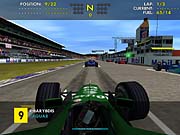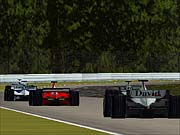EA Sports' F1 2001 is the company's latest iteration of its impressive Formula One simulation series, and like many of the company's other sports franchises, it poses a small dilemma to those who bought last year's version. Specifically, while the game improves upon a few aspects of F1 2000 and F1 Championship Season 2000, its handful of changes might not be enough to recommend it, especially to those who bought the last Electronic Arts F1 game.

Of course, there are those who can't get enough of Formula One racing, and for those people, the enhancements of F1 2001 will undoubtedly be welcomed. The most obvious of these changes is that F1 2001 is based on the 2001 season of Formula One racing, which means that you'll be able to experience all 17 tracks, as the actual participants did this year. Even the weather in each race has been modeled to mimic the conditions of the actual events. Naturally, all 11 teams and 22 drivers from this past season are also available in F1 2001, including veteran Michael Schumacher and rookie Juan Pablo Montoya, as are the cars from Ferrari, Jaguar, McLaren, and BAR.
There are other changes as well, such as a fully 3D pit crew that you can actually see change your tires and top off your fuel. You'll schedule pit stops before the start of every race as part of your refueling strategy--F1 2001 actually models the weight of your fuel, so an empty fuel tank means a faster car. Of course, a change in weather conditions can warrant an unscheduled pit stop, and you can do that as well. As dangerous as it to drive in the rain with dry tires, fans of this series will welcome the addition of changing weather conditions, which is something that none of EA Sports' F1 games have had before. In F1 2001, a race can start under dry conditions and then quickly deteriorate into a monsoon, which not only handicaps the handling of your car, but also severely limits visibility, especially when driving behind the rooster tails that the cars will create on the wet asphalt.
F1 2001 seems to have been made with drivers of all skill levels in mind. In addition to the standard driving aids from F1 Championship Season 2000, F1 2001's driving school mode has been updated to be more user-friendly--and it is. In fact, the designers of the game seem to have taken a cue from Gran Turismo 3's license tests, as each of these sessions employ color-coded driving lines and audio tips to make learning the basics of driving an F1 car more intuitive than it was in the company's two previous games. And instead of just one training car, F1 2001 now has three cars to choose from, including a rare three-seater from Arrows. The differences between the three cars is strictly visual, though. Unlike the PlayStation 2 version of this game, F1 2001 won't force you to complete driving school before being able to compete in the championship mode.
F1 2001's graphics have also been given a touch-up, so now the cars boast even more detail than before, especially in the cockpit view, and the tracks seem to be populated by a few more objects, like flags in the grandstands. The various effects--such as reflections, environment mapping, and gravel particles--seem to be updated as well, although only the most discerning eye will be able to notice those changes. Unfortunately, these additions come at the price of performance. The game's minimum system requirements have jumped up 100MHz from those of F1 Championship Season 2000, and on a 1GHz test system with a GeForce 2 Ultra graphics card, we were unable to run the game at its full settings while still retaining a manageable frame rate. Additionally, with full detail turned on, we noticed several visual artifacts on the car models and the track itself.
The cars in the game also seem to be touchier than in F1 2000 and F1 Championship Season 2000, as it's a little tougher to keep them from sliding across the track this time around. However, this is simply the nature of Formula One cars, and besides, like the graphics, only the most discriminating player will be able to note the difference in handling. 
Otherwise, F1 2001 is essentially the same game as the last EA Sports F1 game. The championship mode will take you through all 17 of the F1 season's tracks as any of the 11 teams' 22 drivers and will let you fiddle with an endless array of performance parts for your car, including tire compound, bump, rebound, ride height, spring rate, camber, steering lock, gearing, and much, much more. There's a quick race mode for those who simply want to jump into a car and test their mettle against other opponents for a few laps. The multiplayer component has also remained unchanged, which is unfortunate, because there's still no player-matching ability within the game--you need to know the exact IP address of whoever it is you're connecting to. The sound effects also remain largely unchanged and do a great job of conveying the bansheelike wail of these cars' monstrous engines at full throttle and their low, hollow growl at idle.
Those who bought F1 Championship Season 2000 when it came out 10 months ago might not find the handful of enhancements in F1 2001 all that appealing--and with good reason. The changes to the game are marginal at best, and F1 2001 carries a full price tag. However, die-hard Formula One fans need look no further than F1 2001 for the most up-to-date--visually or otherwise-- F1 racing game on the market.